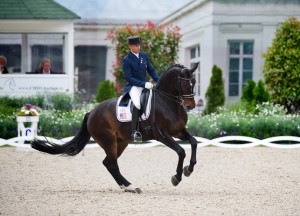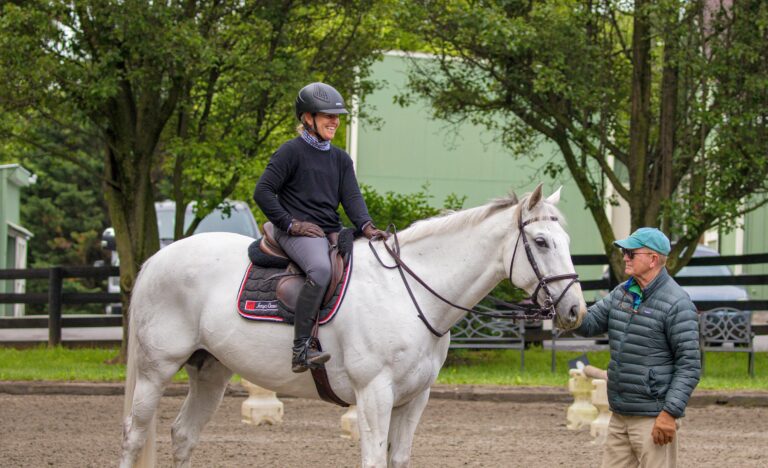When I teach people how to ride, I need to be able to communicate a great deal of information in a short period of time. One of the ways I do this is to use aphorisms, which Webster’s Dictionary defines as “a short, pointed sentence expressing a wise or clever observation.” If a student persists in making the same mistake, I tell them, “Even white rats learn from experience.” This aphorism is terse, gets my point across and is certainly memorable, if you are the poor unfortunate on the receiving end.

Another technique I use is to say, “K.I.S.S.,” which stands for “keep it simple, stupid.” This certainly applies to riding horses, where our final goal is elegant simplicity.
Of course, as soon as I think “simple,” all the experts I carry around in my head start talking at once, and it is hard to concentrate. (Have you seen my new bumper sticker? It says, “You’re just jealous because the voices in my head are talking to ME, not you!”)
For example, I can hear celebrated Polish novelist Joseph Conrad saying, “Thought is the enemy of perfection,” and Supreme Court Justice Oliver Wendell Holmes saying, “I would not give a fig for the simplicity on this side of complexity, but I would give my life for the simplicity on the other side of complexity.” Or, what about the lovely quote from English critic, essayist and social reformer John Ruskin: “It is far more difficult to be simple than to be complicated.” My personal favorite is, “Genius does not consist of making the simple appear complex, but rather making the complex appear simple.” When you get down to it, the difference between bad riding and good riding is that you can’t see good riding. It’s simple; it’s just not easy.
Simplify, Simplify
You may be thinking that this is all interesting, but how will it help your riding on a daily basis? Try this: When you ride, don’t make things more complicated than they need to be.
For example, imagine that you are working on your horse’s dressage. Every time you turn down the centerline, he drifts to the left. Being human, you immediately turn down the centerline again, and this time, you pull on the right rein. Not only does this not help, it makes things worse. Now, he is drifting left off of the centerline, but he is bent to the right. The more you pull on the rein, the more he bends right and drifts left. Finally, some dimly remembered voices in your head (there they are again) remind you to straighten your horse with your legs, not your hands, so you try the centerline again, and close your legs. Worse. Now he is not only drifting left, but he is also starting to rush and lean against the bridle.
In frustration, you finally take a break, and think back to this column. K.I.S.S., remember? Whenever things are going wrong, I want you to figure out, “What is it that I might be doing to cause my horse to react this way? What could I be doing to cause him to drift left?” You recall that things got worse as you added more and more aids, only to wind up in a puffing, sweating snarl of failed horsemanship. Let’s try this: When you start work again, get your horse settled and working quietly at all three paces. He has been drifting left, so “cheat” a little and work mostly on the right hand, so that the wall on your horse’s left shoulder helps to keep him straight.
When you feel a little better about how he is going, turn down the centerline again; this time, however, I want you to take away one aid, not add more. During the break, your thinking should have gone like this: “If I use one leg more than the other, my horse will move away from my active leg. I don’t think my aids lack symmetry, but let’s see.” Down the centerline you go again, but this time you keep your hands quiet, and instead of adding any aids, you merely soften your right leg. In other words, take away the aid that might be causing the problem. Ride your horse down the centerline, and observe his reactions.
Chances are you either made things better, or they stayed the same. Either way, you know more than you did a moment ago. If your horse continued to drift to the left, you at least have the satisfaction of knowing you are not part of the problem. The solution then becomes simple: Add more left leg at the girth until your horse becomes straight.
Check Yourself, Check Your Horse
Occasionally, taking away one leg will cause miraculous results in terms of straightness. Before you start beating yourself up about how crooked you must have been, check your position by riding straight at a mirror or at a friend with a video camera. I often find the root cause of the problem is not so much that the rider is crooked, but that the horse is more sensitive on one side of his body than he is on the other. While this is valuable information, notice that we learned it by softening our aids and listening to our horses instead of mindlessly “stacking” more and more aids.
To digress for a moment, I think many coaches tell students to straighten their horses with their legs, when what they really mean is that students should straighten their horses with their leg. If we apply both legs on horses who are out of alignment, we usually produce horses who are even more out of alignment.
This simplification of your riding should occur in every aspect of training, whether in dressage, show jumping or cross country.
For example, you should go through the same sort of mental exercise when you have problems with your cross country or show jumping. First, analyze your problem. One of the most common problems eventers have jumping is that their horses “rush,” or increase their speed in the final few strides before the obstacle. If your horse rushes in the approach, think to yourself, “What could I be doing that might make my horse speed up in the approach?”
I often find that when riders are dealing with this problem, they do not just resist with their hands; rather, they go tense all over their bodies, including their legs. They are thinking, “I wish this idiot would slow down,” but their body language is telling their horses “go.” It is simple. (There’s that word again.) If you do not want your horse to speed up, first make sure you are not kicking him. The next time you approach an obstacle, try this: Maintain the same contact you had with the reins, but soften your heels. I often tell my students to take their legs off their horses’ sides in the approach. This is not exactly what I mean, but it gives them permission not to close their heels on their horses’ sides as they get close to the jump.
To practice this, slightly lower the fence you are working over, or find a smaller log if you are schooling cross country. Make a circle near the obstacle and get your horse settled and quiet at the canter. Once he’s relaxed, consciously take your legs away from his sides and approach the obstacle with a wait-and-see attitude. If you have problems with your own nerves in the approach, count the rhythm of the stride out loud or sing in rhythm with your stride, anything to keep yourself and your horse relaxed in the approach. You might be surprised to get a slightly “sticky” effort from a horse who was jumping like a rocket a few moments ago.
A Good Step Backward
Once a year when I am trying this technique with a student, the horse will actually stop in front of the obstacle. If this happens to you, just pat him (he did what you told him to do after all, even if it wasn’t exactly what you meant) and think for a moment that you just dribbled to a halt in front of the obstacle on a horse who was nearly dangerous a few moments ago. You achieved a dramatic change in your horse’s attitude by a simple change in the balance of your aids. True, you tipped the balance in such a way as to produce a stop instead of a rush, but you should think of that as a step backward in the right direction. The key element to this entire process is to remember that you changed your horse by simplifying, not stacking, your aids.
This general technique can be applied to other jumping situations as well. For example, the same horse I mentioned earlier, who wants to drift left on the centerline, will usually approach an obstacle straight but will jump to the left as he leaves the ground. Use the same right-leg-off/left-leg-on technique that worked for you on the flat. This will usually correct his drift, just as it did on the centerline.
There are countless moments when we can improve our horses, but we have to remember to first think of what we might be doing that would cause our horses to react this way and, most of all, to K.I.S.S.
This article originally appeared in the June 2012 issue of Practical Horseman.










